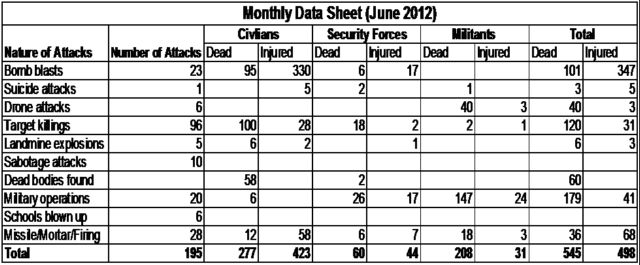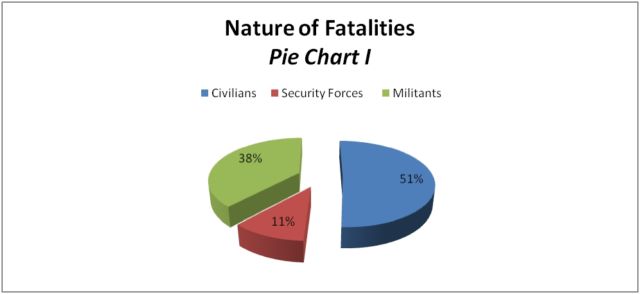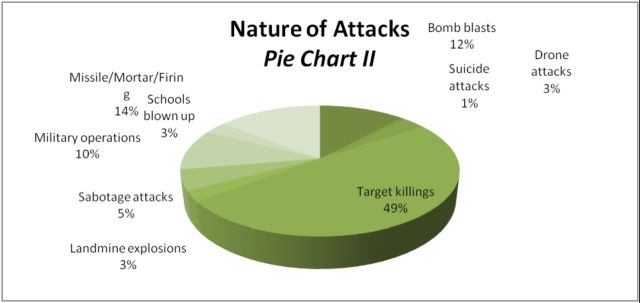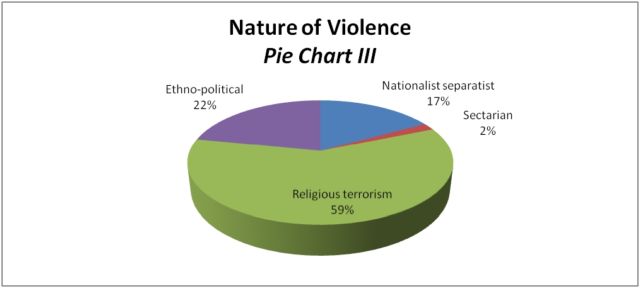Ethno-political violence in Karachi, religio-terrorism violence in Federally Administered Tribal Areas (FATA) and Khyber Pakhtunkhwa (KP), and nationalist-separatist violence in Balochistan led to the decimation of staggering 544 persons during June. Meanwhile, renewed wave of religio-terrorism violence in FATA and KP ate up almost 324 persons during the month under review. The data collected through different sources suggests that some 545 people lost their lives in 195 incidents of violence across the country (for details see data sheet). It also underlines that the overall level of violence escalated in June in comparison to May, wherein 530 people were perished. The violent clashes also left 498 people injured across the country during the reported month.
Trail through data suggests that the defenseless civilians remain the primary target of violent actors, with the civilians accounting for almost half of the total deaths in various acts of violence and terror across Pakistan. As noted in pie chart I below, civilians accounted for almost 51 percent of the total dead in June. The proportion of the civilian deaths isslightly lower than the previous month, when 54 percent of the dead were innocent civilians. As a whole, 277 civilians were killed in different circumstances during the month. The second highest number of fatalities were of militants– i.e. 38 percent of the total dead, 11 percent deaths were of the security forces and these were mostly recorded in insurgency infested areas of KP and FATA. Furthermore during June, six CIA operated drone strikes were reported in different areas of South and North Waziristan Agency (FATA), leaving as many as 40 killed, most of them reportedly suspected militants. On the contrary during last month, eight drone attacks were reported. Between March and June of this year, 18 drone attacks have left 123 suspected militants dead. Meanwhile, carrying on their sabotage campaign to disrupt and dismantle state infrastructure, militants blew up six government schools in different parts of FATA and KP during the course of month. Also, 10 sabotage attacks were reported in parts of Balochistan and KP, wherein miscreants blew up gas pipelines and power pylons.
During the current week, frequent clashes between military and militants were the major cause of deaths; 179 people were killed, including 147 militants and 26 security forces personnel in different areas of KP and FATA. Meanwhile, Target-killings were the second major cause of deaths. As pie chart II below depicts that a staggering 22 percent of the total deaths were the direct consequence of target killing, and 120 persons were shot dead across Pakistan in 96 incidents. Karachi witnessed the major loss of lives as a result of target killings, wherein 108 persons were shot-dead during the month under review. Meanwhile, in June, 60 dead bodies were also recovered in different parts of Pakistan, most of them though found in Karachi, FATA and Balochistan. The third major cause of the violence was bomb attacks. In total, 101 persons including 95 civilians and six security forces– personnel perished in such attacks. Likewise, one suicide attack left two security forces– men dead and five civilians injured in FATA, the hotbed of war on militancy.
Furthermore, the sporadic episodes of sectarian violence continue to make the minority Shia Muslims bleed. During the current month, ten people were shot dead out of sectarian motives; eight in Quetta and two (Sunni Muslims) in Karachi as a result of six violent incidents. Latest trends suggest that sectarian violence is going to grip Pakistan relentlessly in future. Since so far, the government has failed to arrest even a single person involved in sectarian attacks in Quetta.
During the last three months (April-June), 1478 persons have been killed across Pakistan. June was the most violent month out of these three months, wherein large numbers of deaths were reported due to the clashes between military and militants in FATA and KP regions. Though violence drastically declined during April when there was relative respite in war on militancy in FATA. But during May, violence picked up again in the said areas and peaked during the current month. The unfolding violent trends suggest that violence is gripping FATA, KP, Balochistan and Karachi evenly. The salient feature of the month was frequent clashes between military and militants in militancy stricken areas of FATA and KP. According to reports, militants have closed ranks and struck deals among splinter groups in the said areas to multiply their strength, in order to better take on the security forces. Also, cross border attacks from Afghanistan resulted in the killing of almost two dozen security forces– men and scores of militants during the last week of June. The trend underlines an alarming situation for the security of Pakistani borders, since there are credible reports that the militants who fled Malakand during 2009 military operation are regrouping in Kunar province of Afghanistan to launch cross-border assaults against Pakistani security forces. Meanwhile, the prevalent political instability and wrangling among different state institutions is detrimentally contributing towards the prospects of violence mitigation and conflict resolution in the country.
Sources
- The News
- Dawn
- The Express Tribune
- Pakistan Today
- Daily Times
- The Frontier Post
- Jang (Urdu)
- Daily Mashriq (Urdu)
- Aaj (Urdu)
- The Nation





